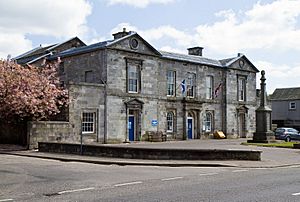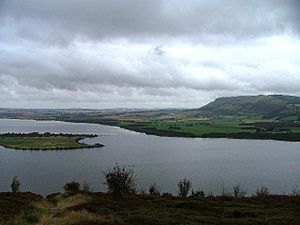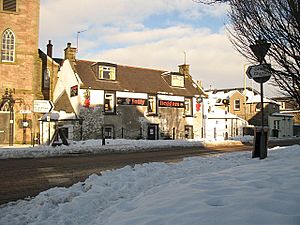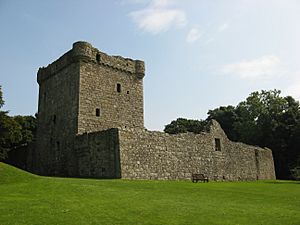Kinross-shire facts for kids
Quick facts for kids
Kinross-shire
|
|
|---|---|
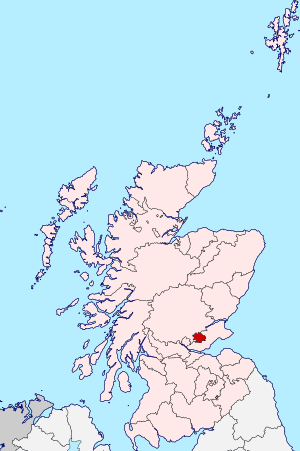 |
|
| Country | Scotland |
| County town | Kinross |
| Area | |
| • Total | 73 sq mi (189 km2) |
| Ranked 33rd of 34 | |
| Chapman code |
KRS
|
Kinross-shire is a historic area in eastern Scotland. It's also known as the County of Kinross. Today, it's managed as part of Perth and Kinross. The main town in this area is Kinross.
Kinross-shire is surrounded by Perthshire to the north and Fife on its other sides. It's Scotland's second smallest historic county. A big part of the area is taken up by Loch Leven. This is a large lake with two islands. It's also an important place for nature. One of the islands has a castle where Mary, Queen of Scots was once held.
Most of Kinross-shire's land is good for farming. Many people who lived here long ago worked in agriculture. The land around Loch Leven is gently rolling. But as you go further out, the land becomes steeper and more rugged.
Contents
History of Kinross-shire
The area of Kinross-shire was first created in the 1200s. Two parishes, Kinross and Orwell, were taken from Fife to form it. Later, in 1685, three more areas called Cleish, Portmoak, and Tullibole were added.
As local government in Scotland changed, Kinross-shire got its own local council in 1890. This council worked from the County Buildings, Kinross. However, in 1930, this council joined with the Perth County Council.
The number of people living in Kinross-shire went down in the 1800s and 1900s. Many moved to cities to find jobs in factories. For example, in 1891, there were 6,673 people. By 1971, it was 6,423. The closure of local railways after the Second World War also made this decline faster.
However, things have changed recently. A new motorway, the M90, was built. This has made the area easier to reach. More tourists now visit, drawn by the quiet villages and beautiful hills around Loch Leven. Villages like Kinnesswood and Scotlandwell are popular. There are also old standing stones at Orwell. A big music event, the T in the Park festival, was held in Balado from 1993 to 2014.
The economy of Kinross-shire has improved. In 2009, about 12,997 people lived there. The area's economy was doing better than the average for Perth and Kinross and Scotland as a whole. The Kinross-shire Partnership helps to promote the area. This group includes local government, tourist groups, and other local organisations.
Geography and Nature
Kinross-shire is a landlocked area, meaning it has no coast. Most of it is flat. However, in the north-west, you'll find the Ochil Hills. The Cleish Hills are along the southern border. The highest point in Kinross-shire is Innerdouny Hill in the Ochils, which is 497 meters (1,631 feet) tall.
The most important natural feature is Loch Leven. This lake is also a very important nature reserve. It has several islands. The biggest island is St Serf's Inch. Other islands include Alice's Bower, Castle Island, and Scart Island. There's also a smaller lake called Arnot Reservoir to the east of Loch Leven. A small part of the Glenfarg Reservoir is on the far northern border.
Towns and Villages
Kinross-shire has several towns and villages. The main town is Kinross.
- Carnbo
- Cleish
- Crook of Devon
- Dalqueich
- Drunzie
- Duncrievie
- Glenfarg
- Glenlomond
- Kinnesswood
- Kinross
- Milnathort
- Scotlandwell
- Stronachie
- Tillyrie
Travel and Transport
The M90 motorway runs through Kinross-shire from north to south. This road connects Kinross to Perth in the north and Dunfermline in the south. The A911 road allows people to travel from west to east across the area.
There are no train stations in Kinross-shire today. The station that used to be in Kinross is no longer open.
Coat of Arms
The Kinross County Council received its own coat of arms on May 18, 1927. The design on the arms shows Loch Leven Castle. The council chose the motto "for all time." At that time, they were trying to stay independent from their larger neighbour, Perthshire.
When the Perth and Kinross District Council got its coat of arms in 1977, the Kinross-shire arms were placed on a small shield in the middle of the new design. These arms are still used by the current Perth and Kinross Council.
Places to Visit


